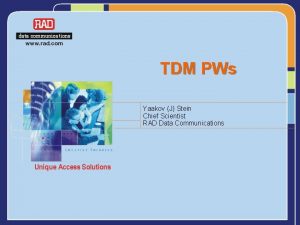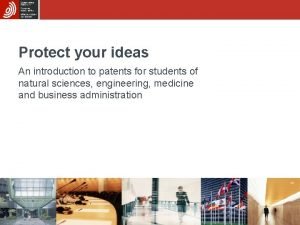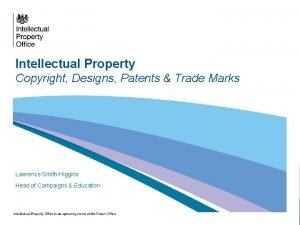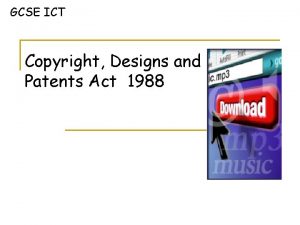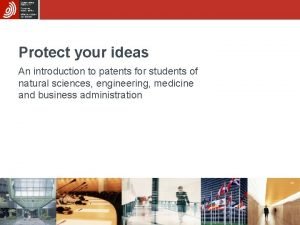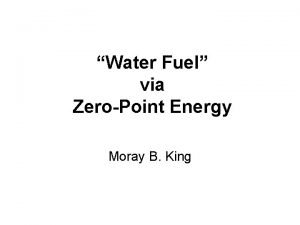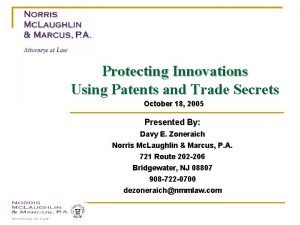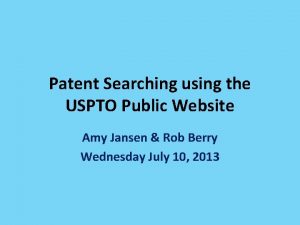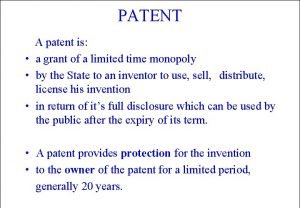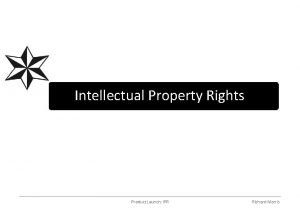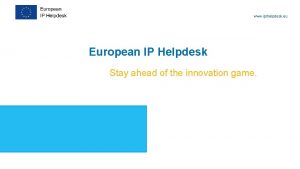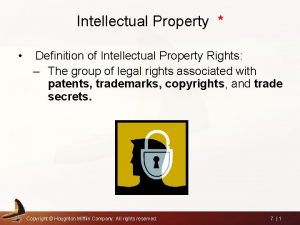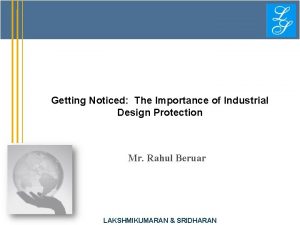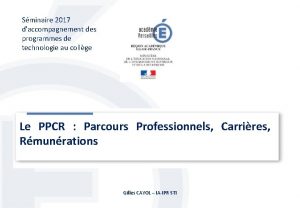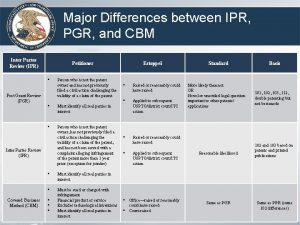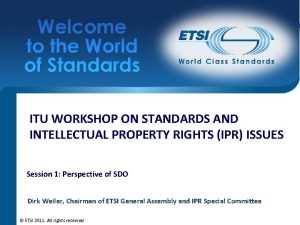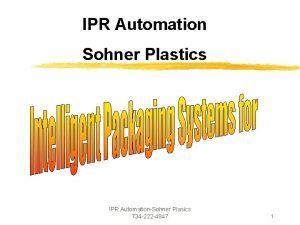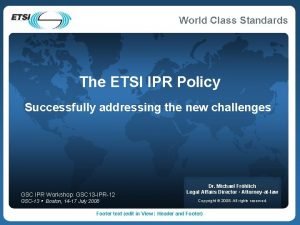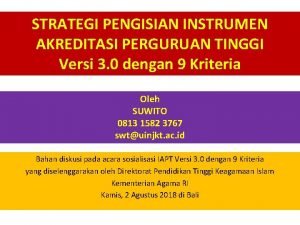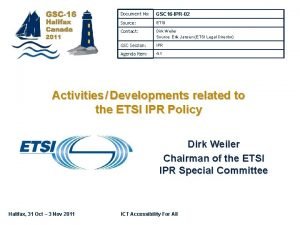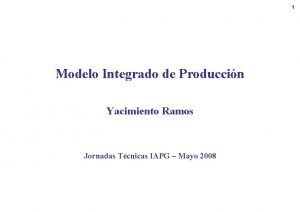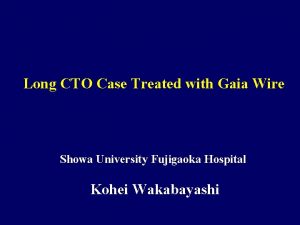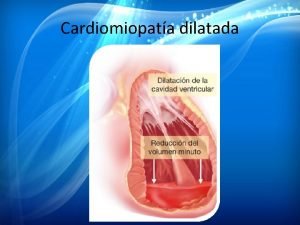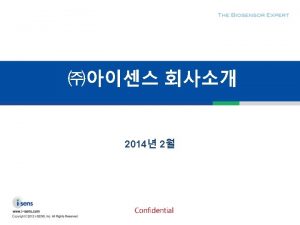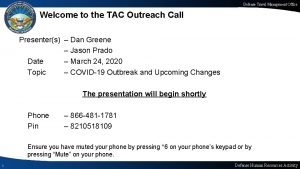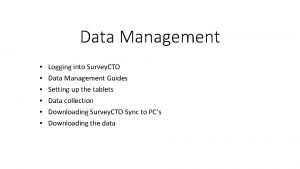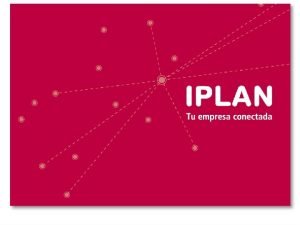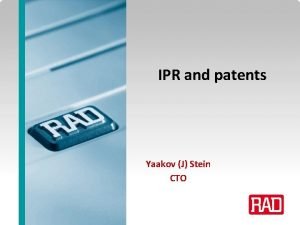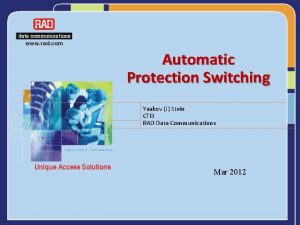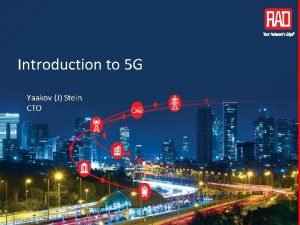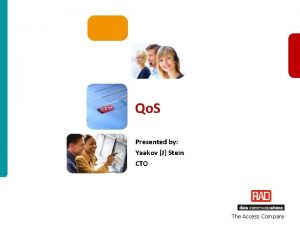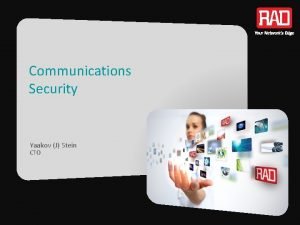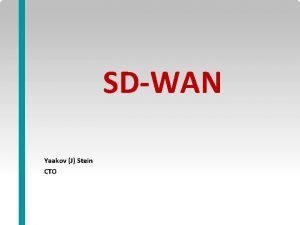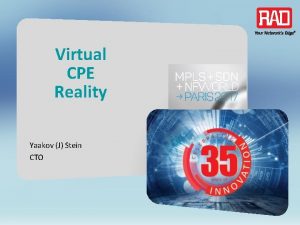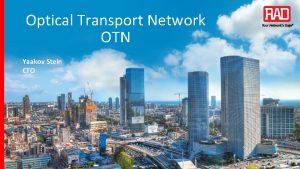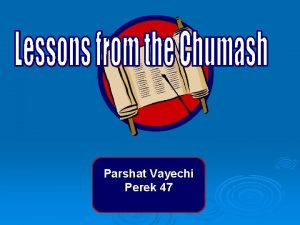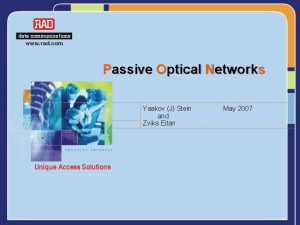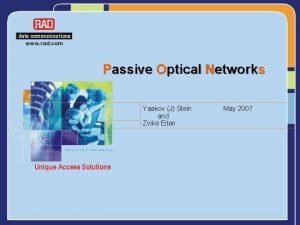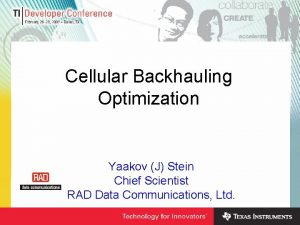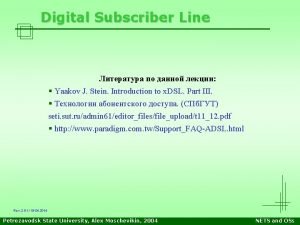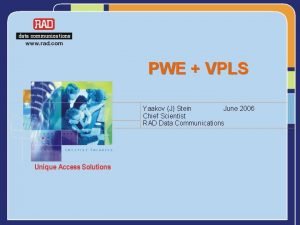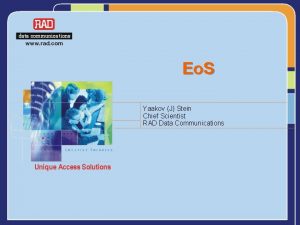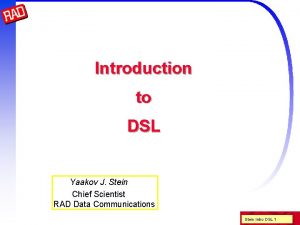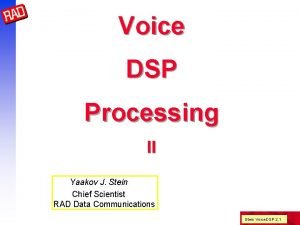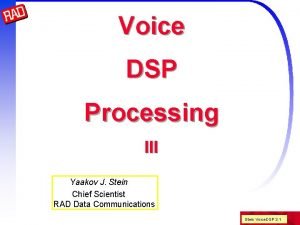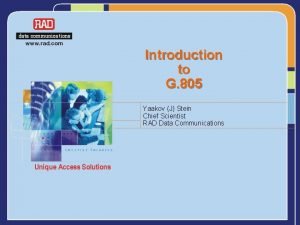IPR and patents Yaakov J Stein CTO IPR



























- Slides: 27

IPR and patents Yaakov (J) Stein CTO IPR and patents Slide 1

Types of property • Real property • Personal property • Intellectual property (IPR) IPR and patents Slide 2

4 ways to handle technological IPR Secrecy e. g. , Karmarkar’s algorithm Idea: keep the competition in the dark Protection e. g. , patenting sensitive technologies Ideas: claim ownership, directly block competitors Standardization e. g. , participation in standardization bodies Ideas: grow market, influence final technology Publishing (releasing to the public domain) e. g. , articles in professional journals, lectures at open conferences Ideas: expert recognition, keep others from blocking you IPR and patents Slide 3

Types of IPR • utility patents (inventions) • design patents (industrial designs) • copyrights • trademarks • trade secrets • trade dress (distinctive packaging) • publicity rights (of celebrities) • geographical indications (terroir, e. g. , of wine) • database rights (EU) • . . . IPR and patents Slide 4

Why IPR ? IPR creates an artificial monopoly – why is this justified ? • utilitarian (economic) theory – promote innovation and incentivize progress in arts and sciences • labor desert theory – natural rights – Lockean proviso (there is enough left in common for others) • moral rights Note that all forms of IPR are limited • in term • in jurisdiction • in scope IPR and patents Slide 5

IPR law Unauthorized use of someone else’s IPR is called infringement • Infringement may be the subject of civil law or criminal law • Infringement does not necessarily require knowledge but willful infringement may be more serious (e. g. , triple damages) IPR rights • are always limited in time duration • are usually limited to a given jurisdiction • sometimes require registration and/or examination in a jurisdiction There are ways to legally use someone else’s IPR • assignment • exclusive license • non-exclusive license A license is an authorization/permission by the IPR owner to exercise a privilege that otherwise would constitute infringement License terms often involve payments IPR and patents Slide 6

Utility patents • promote progress in science and technology • rights are per jurisdiction – each country has national patent office (e. g. USPTO) – in EU - European Patent Organization (EP) – Paris convention – Patent Cooperation Treaty (PCT) - WIPO • grant exclusivity to inventor against infringement – making, using, selling, offering for sale, exporting – not against researching, drawing, thinking about – note - unlike copyright, infringement does not require copying • exclusivity is for a limited period of time – in US: 20 years from filing (once was 17 years from grant) • priority and first to file IPR and patents Slide 7

Requirements • Utility – must be industrially/commercially useful • Novelty – must not be previously known/used/published/patented – in US, inventor may publish up to 1 year before application – elsewhere – no prior disclosure is allowed – applications are usually published after 18 months • Non-obviousness – to a person well versed in the art – once required creative spark – sufficiently different from existing knowledge – only real advances are awarded patents IPR and patents Slide 8

Why patent ? There are many reasons to apply for a patent • offensive – licensing and royalties – monopoly – NPE (trolls) • defensive – protect market share – freedom to operate – balance of fear • valuation – IPR is a significant fraction of value of technology companies • >80% of value of S&P 500 companies is intangible • upon acquisition may add M$ per issued patent to company value IPR and patents Slide 9

What can be patented? Given Utility, Novelty, and Non-obviousness the following types of inventions can be patented • machines (man-made products) • processes (including some algorithms) In the US, the machine or transformation test was often used • is the invention implemented by a particular machine ? • does the invention transform an article from one state to another ? IPR and patents Slide 10

What can not be patented? Some examples : • abstract ideas • natural phenomena, law of nature, scientific theories • mathematical facts and methods • methods for performing purely mental acts • computer programs • presentations of information • purely aesthetic creations (literary works, music compositions) • forms of energy • naturally occurring genetic material (DNA sequences) IPR and patents Slide 11

Software Algorithms may be protected by patents Databases may be protected (in the EU) by the database directive Source code may be protected by copyrights Some history (in the US) will help explain … 1974 Commission on New Technological Uses of Copyrighted Works decided that computer programs, to the extent that they embody an author's original creation, are proper subject matter of copyright 1980 US Congress added computer program to copyright law 1983 Apple vs. Franklin: Court of Appeals decides that even object code is subject to copyright 1986 Whelan v. Jaslow, Broderbund v. Unison: extended software copyright to structure, organization, look-and-feel 1997 No Electronic Theft Act raises criminal penalties (even w/o monetary gain) to 5 years + 250 K$ + higher civil damages, closing the La. Macchia loophole IPR and patents Slide 12

How much is a patent worth ? Patents can be sold, so patents have monetary value How can this value be estimated ? • compare to price of similar patents recently sold – – – often hard to know, since price is frequently not released a consortium offered 1. 3 M$ for Orckit’s close to 200 patents – about $7. 5 K per patent RAD just purchased a patent with 5 years left to run for $60 K RAD once sold a patent for $250 K IPOfferings LLC says that the average paid for issued US patent is $375 K Google acquired Motorola Mobility, essentially for its 17, 000 patents, for $12. 5 B, i. e. , about $735 K per patent – Rockstar consortium (Apple/Ericsson/Microsoft/Sony) paid 4. 5 B$ for 6000 patents from bankrupt Nortel (easily trumping Google that bid a mere 900 M$), i. e. $750 k per patent! • how much is it worth to a NPE (troll)? – number of potential infringers – royalties (Georgia-Pacific factors) • how much is it worth to a PE? – save litigation costs (average $5 M per suit) – save royalty payments – freedom to operate • technical valuation IPR and patents Slide 13

Stages in patenting The following need to be performed in each jurisdiction • Prior art search • in the US - you may want to file a provisional application • Drafting • Filing (from now on patent pending) • Publication (usually after 18 months) • Prosecution (office actions, final office action, RCE, appeals) • Allowance • Fees • Issuance (patent number) • Marking • Maintenance (periodic fees) Expected expense to receive a US patent $10 K-$20 K Expected expense to receive worldwide family coverage $50 K-$100 K Yearly maintenance on a worldwide family $5 K IPR and patents Slide 14

Provisional patent applications Since 1995, the US PTO allows filing a provisional application Provisional applications • have lower fees • are simpler to prepare (do not even require claims) • do not require filing Information Disclosure Statements • capture a priority date • allow the filer to mark products patent pending but • are never examined and thus never become patents there is no such thing as a provisional patent ! • only last for 1 year and can not be extended • all rights are lost if you don’t file a nonprovisional patent application So, it is worthwhile filing a provisional patent applications • if you are unsure of the usefulness of the invention • if you are waiting for funding to develop the invention (and pay fees) IPR and patents Slide 15

Where to file? Patents are per jurisdiction and each patent office has its own requirements • US • Canada • EPO – common examination, but need to file in each country! • PCT (Patent Cooperation Treaty) – no protection by itself! • Japan • China To decide, consider • where are your competitors? • where are your customers? IPR and patents Slide 16

Patent families There are often many related patents in a family • similar patents in different jurisdictions – may be different due to different requirements and details of prosecution process in various patent offices • continuation – additional claims to previous patent – must be filed before issuance of original patent • divisional – distinct variant – often filed following examiner restriction relating to multiple inventions – must be filed before issuance of original patent • Continuation In Part – adds subject matter not in original patent – retains priority date (and term) of original patent – must be filed during lifetime of original patent IPR and patents Slide 17

Format of US patent • First page – number, title, dates, inventors, assignee, search codes, references, credits, abstract, figure • Drawing sheets • Description – Background (including field of invention and prior art) – Summary – Brief description of drawings – Detailed description of preferred embodiment(s) • Claims – independent – claim language is not plain English IPR and patents Slide 18

First page IPR and patents Slide 19

Drawing sheets . . . IPR and patents Slide 20

Description IPR and patents Slide 21

Claims • claims define the patent coverage • must define technical features • (description defines terms used) IPR and patents Slide 22

Claim language A claim consists of • Preamble – An apparatus, A device. . . – A method. . . – A system. . . –. . . according to claim X • independent vs. dependent claims • Transitional phrase – comprising. . . – having at least one. . . • Limitations describing how desired result is achieved • Purpose (Optional) describing the invention’s goal – wherein. . . – whereby. . . IPR and patents Slide 23

Claim types There are many types of claims: • method/process/use claim – mathematical – computer-aided process • product/apparatus claim • system claim • means plus function • business method (Bilski, Alice) Consider who will infringe • the end user • a competing vendor • a component manufacturer Consider how infringement will be proven IPR and patents Slide 24

RAD’s issued patents TDMo. IP family US 6, 731, 649 TDM OVER IP (IP CIRCUIT EMULATION) DE 60125107 TDM über IP (IP-Schaltungsemulation) France 1, 176, 774 TDM OVER IP (IP CIRCUIT EMULATION SERVICE) UK 1, 176, 774 TDM OVER IP (IP CIRCUIT EMULATION SERVICE) EP 1, 176, 774 TDM OVER IP (IP CIRCUIT EMULATION) Timing family US US 8, 068, 430 HIGH QUALITY TIMING DISTRIBUTION OVER DSL WITHOUT NTR SUPPORT US 8, 660, 150 HIGH QUALITY TIMING DISTRIBUTION OVER DSL WITHOUT NTR SUPPORT divisional US 8, 971, 356 TIMING OVER PACKET DEMARCATION ENTITY US 9, 525, 502 TIMING OVER PACKET DEMARCATION ENTITY divisional SFP functionality family US 8, 851, 929 SFP FUNCTIONALITY EXTENDER US 8, 641, 429 SFP SUPERCAGE US 8, 982, 726 NETWORK DEVICE US 9, 025, 490 NETWORK DEVICE Mi. CLK family US 9, 276, 689 PLUGGABLE MASTER CLOCK JAPAN 5, 833, 799 EP 2, 901, 587 DE 13, 801, 768 Switzerland/Lichtenstein Finland France UK Italy Austria DSL US 6, 829, 246 SYSTEM AND METHOD FOR EXTENDING THE RANGE OF XDSL SERVICES OAM family US 9, 362 TRIANGLE LOOPBACK IPR and patents Slide 25

RAD’s wall of patents IPR and patents Slide 26

Searching Google patent search www. google. com/patents US-PTO www. uspto. gov/patent WIPO www. wipo. int/patents/en/ EPO Espacenet www. epo. org/searching/free/espacenet. html EP patent wrappers register. epo. org/regviewer US-PTO wrappers portal. uspto. gov/pair/Public. Pair Latest patents www. latestpatents. com/ IP marketplace www. ip-marketplace. org/ Note – many companies do not allow R&D to look at patents in order to avoid willful infringement and triple damages IPR and patents Slide 27
 Yaakov stein
Yaakov stein Advantages and disadvantages of patents
Advantages and disadvantages of patents What is the copyright designs and patents act 1988
What is the copyright designs and patents act 1988 What is the copyright designs and patents act 1988
What is the copyright designs and patents act 1988 Advantages and disadvantages of patents
Advantages and disadvantages of patents Patrick j kelly free energy
Patrick j kelly free energy Types of patents
Types of patents Types of patent
Types of patent Insecticide act
Insecticide act Patents
Patents European ipr helpdesk
European ipr helpdesk Industrial property definition
Industrial property definition Industrial design ipr
Industrial design ipr Grille indiciaire ia-ipr
Grille indiciaire ia-ipr Pgr vs ipr
Pgr vs ipr Etsi ipr database
Etsi ipr database Ipr cnc
Ipr cnc Etsi ipr
Etsi ipr Ipr dalam akreditasi
Ipr dalam akreditasi Etsi ipr database
Etsi ipr database Reservorios
Reservorios Cto vp engineering org chart
Cto vp engineering org chart Gaia second wire
Gaia second wire Manuales cto
Manuales cto Cmo cto ceo
Cmo cto ceo Defense travel management office
Defense travel management office Survey cto
Survey cto Gponhub
Gponhub
